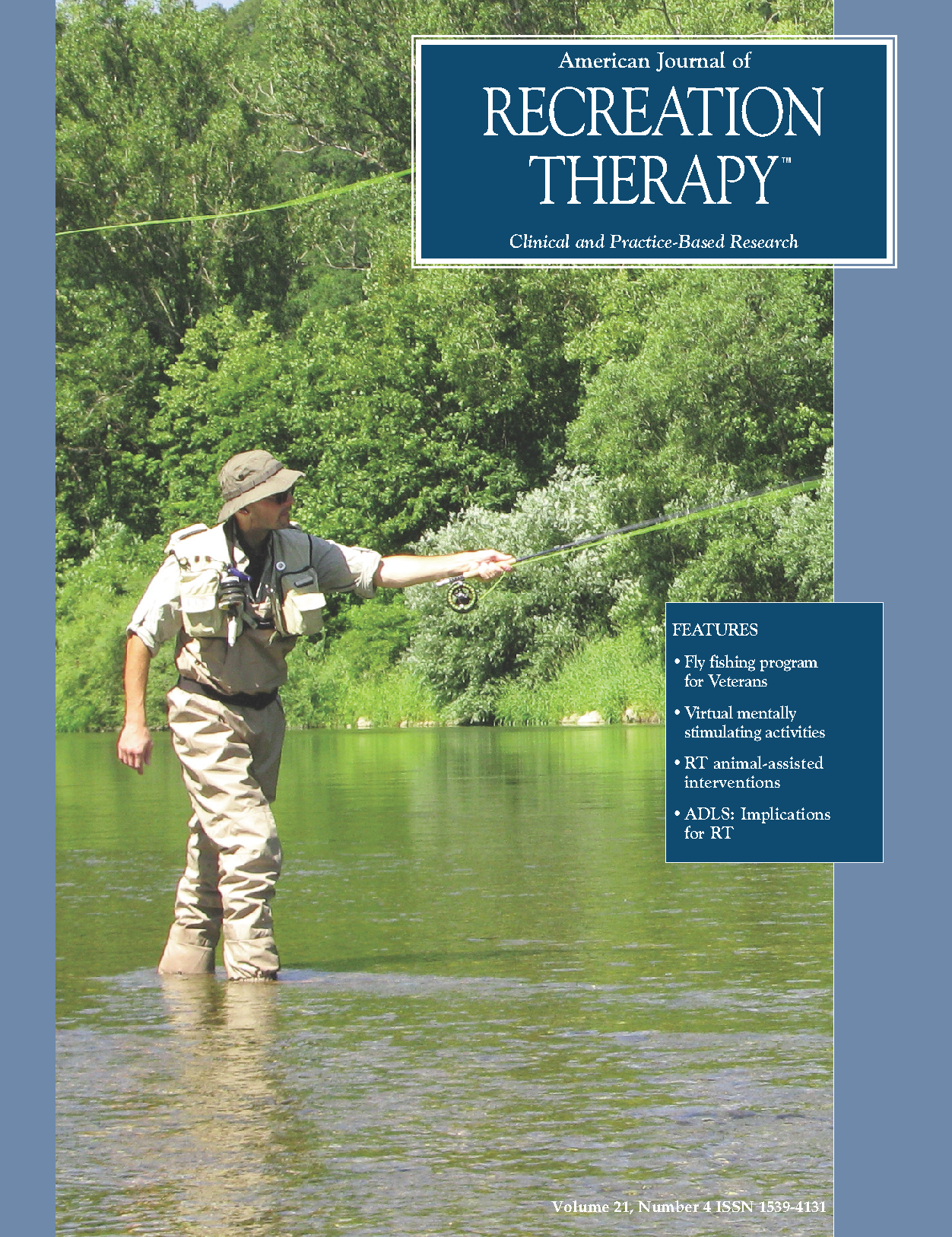Categories of activities of daily living skills: Implications for recreational therapists
DOI:
https://doi.org/10.5055/ajrt.2022.0272Keywords:
ADLs, activities of daily living skills, interprofessional team, recreational therapyAbstract
Activities of daily living skills (ADLs) are functional skills that determine the independence of a person with a disability to complete a specific task and to live independently. Through the years, the concept of ADLs has evolved to include a hierarchical classification from basic to more complex activities. Categorization of ADLs identifies if an activity is needed to sustain life, function within a community independently, or for the fulfillment of pleasurable activities and social roles. The three categories, basic, instrumental, and advanced ADLs, can be observed by a clinician to determine current functional status as well as independent living. This article aims to identify ADLs and the categorization of ADLs and describe the three levels of ADLs (basic, instrumental, and advanced), assessment tools for the different levels of ADLs, and implications for recreational therapy practice.
References
Bleijenberg N, Zuithof NPA, Smith AK, et al.: Disability in the individual ADL, IADL, and mobility among older adults: A prospective cohort study. J Nutr Health Aging. 2017; 21(8): 897-903. DOI: 10.1007/s12603-017-0891-6.
Cornelis E, Gorus E, Van Schelvergem N, et al.: The relationship between basic, instrumental, and advanced activities of daily living and executive functioning in geriatric patients with neurocognitive disorders. Int J Geriatr Psychiatr. 2019; 34(6): 889-899. DOI: 10.1002/gps.5087.
Edemekong PF, Bomgaars DL, Sukumaran S, et al.: Activities of daily living. StatPearls. 2021. Available at https://www.ncbi.nlm.nih.gov/books/NBK470404/. Accessed August 25, 2022.
Noelker LS, Browdie R, Sidney Katz MD: A new paradigm for chronic illness and long-term care. Gerontologist. 2014; 54(1): 13-20. DOI: 10.1093/geront/gnt086.
Katz S: Assessing self-maintenance: Activities of daily livingmobility, and instrumental activities of daily living. J Am Geriatr Soc. 1983; 31(12): 721-727. DOI: 10.1111/j.1532-5415.1983.tb03391.x.
Lawton MP, Brody EM: Assessment of older people: Self-maintaining and instrumental activities of daily living. Gerontologist. 1969; 9(3, Part 1): 179-186.
Mlinac ME, Feng MC: Assessment of activities of daily living, self-care, and independence. Arch Clin Neurophsychol. 2016; 31(6): 506-516. DOI: 10.1093/arclin/acw049.
Udovicich A, Edbrooke L, Brown T, et al.: Achieving patient-centered goals in oncology: A retrospective analysis of domestic activities of daily living group. Br J Occup Ther. 2020; 83(12): 773-779. DOI: 10.1177/0308022620918757.
Vaes AW, Wouters EFM, Franssen FME, et al.: Task-related oxygen uptake during domestic activities of daily life in patients with COPD and healthy elderly subjects. Chest. 2011; 140(4): 970-979. DOI: 10.1378/chest.10-3005.
Guo HJ, Sapra A: Instrumental activity of daily living. StatPearls. 2020. Available at https://www.ncbi.nlm.nih.gov/books/NBK430685/. Accessed August 25, 2022.
DeVriendt P, Gorus E, Cornelis E, et al.: The advanced activities of daily living: A tool allowing the evaluation of subtle functional decline in mild cognitive impairment. J Nutr Health Aging. 2013; 7(1): 64-71. DOI: 10.1007/s12603-012-0381-9.
Rueben DB, Solomon DH: Assessment in geriatrics of caveats and names. J Am Geriatr Soc. 1989; 37(6): 570-572.
DeVriendt P, Gorus E, Cornelis E, et al.: The process of decline in advanced activities of daily living: A qualitative explorative study in mild cognitive impairment. Int Psychogeriatr. 2012; 24(6): 974-986. DOI: 10.1017/S1041610211002766.
Sposito G, Neri AL, Yassuda MS: Advanced activities of daily living (AADLs) and cognitive performance in community-dwelling elderly persons: Data from the FIBRA study-UNICAMP. Rev Brasil Geriatr Gerontol. 2016; 19(1): 7-20. DOI: 10.1590/1809-9823.2016.15044.
Takechi H, Kokuryu A, Kubota T, et al.: Relative preservation of advanced activities in daily living among patients with mild-to-moderate dementia in the community and overview of support provided by family caregivers. Int J Alzheimer’s Dis. 2012; 41829. DOI: 10.1155/2012/418289.
DeVriendt P, Mets T, Petrovic M, et al.: Discriminative power of the advanced activities of daily living (a-ADL) tool in the diagnosis of mild cognitive impairment in an older population. Int Psychogeriatr. 2015; 27(9): 1419-1427. DOI: 10.1017/S1041610215000563.
Yajima M, Asakawa Y, Yamaguchi H: Relations of morale and physical function to advanced activities of daily living in health promotion class participants. J Phys Ther Sci. 2016; 28(2): 535-540. DOI: 10.1589/jpts.28.535.
Katz S, Ford AB, Moskowitz RW, et al.: The index of ADL: A standardized measure of biological and psychosocial function. J Am Med Assoc. 1963; 185(12): 94-99.
Coyne R: The Lawton instrumental activities of daily living (IADL) scale. Gerontol Soc Am. 2019; 23. Available at https://www.evidencio.com/uploads/files/models/files/1995/091bbc-IADL%20score%20-%20according%20to%20Lawton%20et%20al.pdf. Accessed August 25, 2022.
Graf C: The lawton instrumental activities of daily living (IADL) scale. Am J Nurs. 2008; 108(4): 52-62. DOI: 10.1097/01.NAJ.0000314810.46029.74.
Published
How to Cite
Issue
Section
License
Copyright 2000-2025, Weston Medical Publishing, LLC and American Journal of Recreation Therapy. All Rights Reserved.


